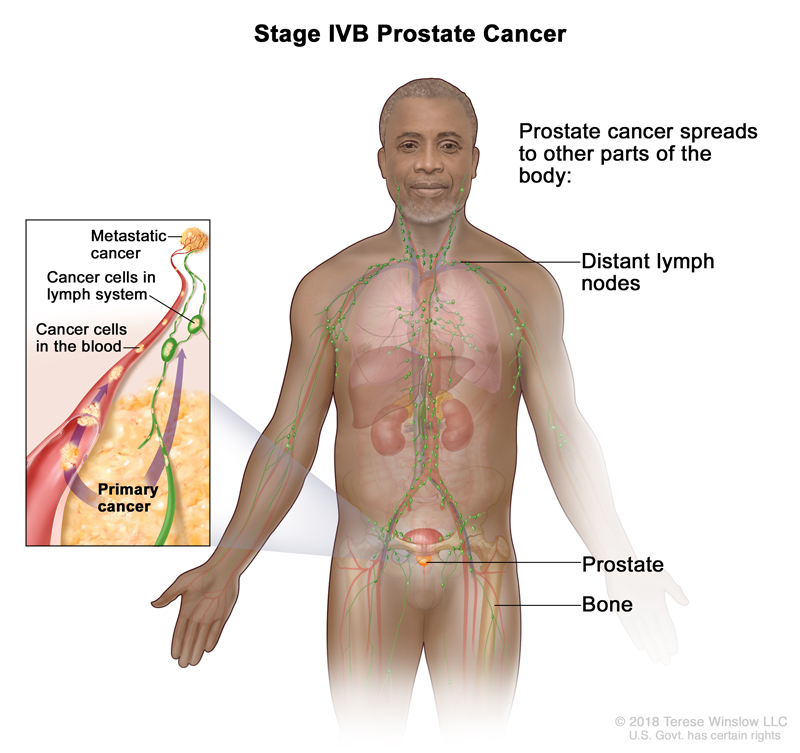Stage 4 Prostate Cancer
Stage 4 Prostate Cancer means the cancer has spread from the prostate to other parts of the body, most commonly the lymph nodes, or the bones. Also called Metastatic Prostate Cancer.
Understanding Stage 4 Prostate Cancer diagnosis will help you and your doctors make the best treatment choice for you. Tap “Watch Now” for an easy-to-understand overview of Metastatic Prostate Cancer.
The Stage 4 Prostate Cancer ICD 10 is C61.
- Metastatic Prostate Cancer Diagnosis
- Gleason Score & PSA Explained
Overview
 Listen Now
Listen Now

A Metastatic Prostate Cancer diagnosis means that the cancer has spread to your lymph nodes outside the pelvis or to other organs in your body, most commonly to the bones. This is also call Stage 4B Prostate Cancer.
What Tests Will I Need and Why?
Blood and Imaging tests are done to understand your general health, confirm your diagnosis and determine your cancer stage.
Tissue Analysis is done to identify the cancer cell type and the Gleason Score, which is critical to finding the best treatment option for you.
In addition, your doctors will determine if your tumor is Castration Naive/Sensitive or Castration Resistant to come up with treatment options that are suitable for your specific Prostate Cancer type.
Castration Naive or Castration Sensitive Prostate Cancer is used to describe patients who have not been treated with Androgen Deprivation Therapy (ADT) previously or are not on an ADT at the time of progression or relapse.
Castration Resistant Prostate Cancer is used to define patients who have failed to respond to ADT (PSA elevation or new tumors on imaging tests during ADT treatment).
You may also require special Saliva or Blood Analysis to look for specific mutations (actual changes in your body’s DNA), called BRCA1 and BRCA2.
Re-read this summary as needed and then tap, “Compare My Treatment Options Now“. Our unique Comparison Page will help you understand your FDA-approved treatment options including, who can help you pay for your treatment, where and how each is given and what side-effects you may experience.

Cancer Research U.K. CC BY-SA 4
Gleason Score & PSA Density
A Prostate Cancer diagnosis is based upon the results of staging and two tests called the Gleason Score and the Prostate-Specific Antigen (PSA) tests
Finding Your Gleason Score
Samples of your cancer cells are examined to find out your Gleason Score. A Gleason Score, which will range between 2 and 10, describes how aggressive a prostate tumor is by looking at how similar or different the cancer cells look to healthy cells.
The Gleason Score is made up of 2 grades that range from 1 to 5. A low grade of 1 means that the cells in the tumor look very much like healthy prostate cells. Cells that look completely different to normal cells are assigned a higher score, usually 4 or 5.
- The first grade is given to describe the cells in the largest area of the tumor
- The second grade is given to describe the cells in the second largest area of the tumor.
When these two grades are added together, they give us a Gleason Score between 2 and 10. For example, 3+4 = Gleason Score 7.
Prostate-Specific Antigen (PSA) tests
Your Dr. also measures PSA Density to help determine the aggressiveness of the prostate cancer found. PSA Density is your PSA level, divided by the volume of the prostate gland.
A high PSA density is often a predictor of Prostate Cancer but please discuss your specific situation with your doctors.


Recommended Prostate Cancer Videos


Prostate Cancer
An Overview


Understanding Localized Prostate Cancer
An Overview


Prostate Cancer In The Black Community
Brought To You By Black Health Matters


A Diagnosis and Treatment: Localized Prostate Cancer
A Conversation with Dr. John Lynch


Exercise & Prostate Cancer
From Your Friends @ the Oncology Nursing Society


How Cancer Spreads
Metastatic = Advanced
Commonly Searched Questions
Metastatic Prostate Cancer Survival Rate
Metastatic Prostate Cancer Survival Rate
According to SEER data, Metastatic Prostate Cancer has a survival rate of 31%. For example, if the 5-year relative survival rate for the metastatic prostate cancer is 31%, it means that patients who have that cancer are, on average, about 31% as likely as patients who don’t have that cancer to live for at least 5 years after being diagnosed.
Source: Cancer.gov
Metastatic Prostate Cancer Definition
Metastatic Prostate Cancer Definition
Metastatic prostate cancer is defined as prostate cancer that has spread beyond the prostate gland to other parts of the body. This spread can occur to nearby tissues such as the bladder, rectum, and pelvic lymph nodes, as well as to more distant sites, including the bones, liver, and lungs. Metastatic prostate cancer is often diagnosed at a later stage and can present with more complex symptoms and a greater challenge in treatment.
Source: Aapc.com
Metastatic Prostate Cancer Treatment
Metastatic Prostate Cancer Treatment
Advanced prostate cancer occurs when a tumor that develops in the prostate gland spreads outside the prostate. The most common sites of prostate cancer spread are to the lymph nodes and bones. This is also called metastatic prostate cancer. Currently, no treatments can cure advanced/metastatic prostate cancer. However, there are effective ways to help slow its spread, prolong life, and control its symptoms, including immunotherapy, hormone therapy, chemotherapy, precision medicine and clinical trials.
Source: Uclahealth.org
Metastatic Prostate Cancer Recurrence Rate
Metastatic Prostate Cancer Recurrence Rate
The recurrence rate for metastatic prostate cancer varies based on several factors, including the specific characteristics of the cancer and the treatment received. Generally, metastatic prostate cancer is associated with a high risk of recurrence because the cancer has already spread beyond the prostate gland. Despite advances in treatment, the recurrence rate can be significant, with many patients experiencing recurrence after initial treatment. The exact rate can differ widely and should be discussed with a healthcare provider for personalized information.
Source: Webmd.com
Metastatic Prostate Cancer Symptoms
Metastatic Prostate Cancer Symptoms
Signs and symptoms of metastatic prostate cancer may include:
- Painful urination
- Decreased force in the stream of urine
- Blood in the semen
- Bone pain
- Swelling in the legs
- Fatigue
Source: Mayoclinic.org
Metastatic Prostate Cancer Prevention
Metastatic Prostate Cancer Prevention
Specific prevention strategies for Metastatic Prostate Cancer, which is prostate cancer that has spread beyond the prostate to other parts of the body, are not provided. However, general recommendations to reduce the risk of developing prostate cancer include:
- Healthy Diet: Eat a diet rich in fruits, vegetables, and whole grains, and limit the intake of high-fat foods, particularly those from animal sources.
- Maintain a Healthy Weight: Achieve and maintain a healthy weight through regular exercise and a balanced diet.
- Avoid Smoking: Do not smoke and avoid exposure to tobacco smoke.
- Limit Alcohol Intake: Consume alcohol in moderation or avoid it altogether.
- Regular Check-ups: For those at higher risk (e.g., with a family history of prostate cancer), discuss with your doctor about the potential benefits of regular prostate screenings, such as PSA tests.
These measures focus on reducing general risk factors and supporting overall health. For personalized advice and risk management, consulting with a healthcare provider is recommended.
Source: Mayoclinic.org


